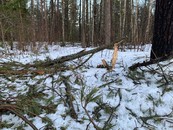|
“Don’t like the weather? Wait five minutes.” A saying that rings true during spring in Wisconsin. While March signals the beginning of spring fire season for us, it can be interrupted by rainfall and snowstorms. Wet weather gives firefighters a chance to recharge and can be an opportunity for people to burn yard debris while it’s safer to do so.
The yard around your home may currently be filled with an assortment of fallen leaves, pine needles and branches. Recent ice storms in northern Wisconsin have contributed significantly to the volume of debris around our homes. If the recent widespread ice storms have damaged the trees on your property, take some time to assess the damage and realistically determine if you can handle the cleanup yourself or if it’s time to call in some professionals. Watch for damaged branches and bent trees that could fall. Prioritize your physical safety before attempting any cleanup activities.

You may now wonder what to do with all this debris leftover after winter and those recent ice storms. Some communities have brush collection services or a site where you can drop off leaves, pine needles and branches. Perhaps there’s enough debris on your property to warrant the rental of a brush chipper. Or, if your property is large enough, creating a brush pile away from buildings could serve as a shelter for wildlife. Larger pieces of hardwood could be cut for future use as firewood or campfire logs. If none of these alternatives works for your situation and your community allows for burning the material, timing your burn around periods of wet weather may be the safer choice.
|

Before you light that match, take the following precautions:
- Check for burning restrictions and permit requirements first. You can find this information on the DNR burning restrictions webpage or by calling your nearest DNR office or fire department. - Check the weather forecast. Delay burning if dry or windy weather is predicted. Be aware of your county’s fire danger forecast by calling 1-888-WIS-BURN or searching “burn” on the DNR website.
- Keep your piles small, with the area around the pile cleared of any burnable vegetation.
- Have an attached hose or other water source handy.
- Stay with the fire until you have completed the burn. Make sure it’s out before you leave by dousing the ashes with water and mixing it in.
- Then, just to be safe, add more water. If any unburned branches or larger pieces of wood remain unburned, check back frequently to make sure this material hasn’t reignited.
|
In Wisconsin, spring fire season typically lasts from snowmelt to “green up” (when the grasses are green and leaves are budding out again). Many parts of our state are still experiencing drought conditions, even coming out of winter. Fire officials will be suspending outdoor burning as needed when fire danger conditions become elevated.
For more information, contact Catherine Koele, fire prevention specialist or Jolene Ackerman, wildland urban interface specialist.
Read all our Wildland Fire Articles posted in chronological order. Remember, each page displays a limited number of articles. Click "older posts" at the bottom of each page to see additional articles.
Read news from other Division of Forestry Programs:
Forest Health News
Private Forestry News
Urban Forestry News
|